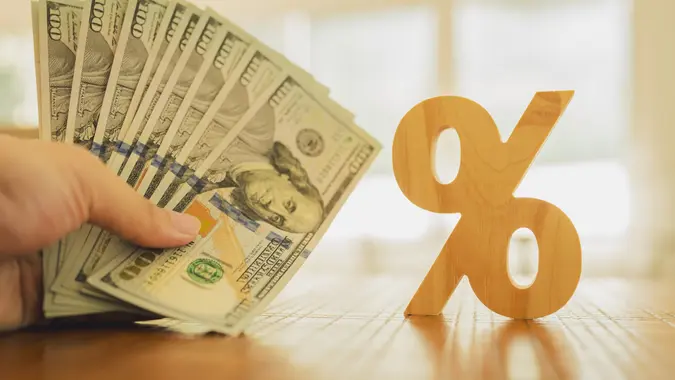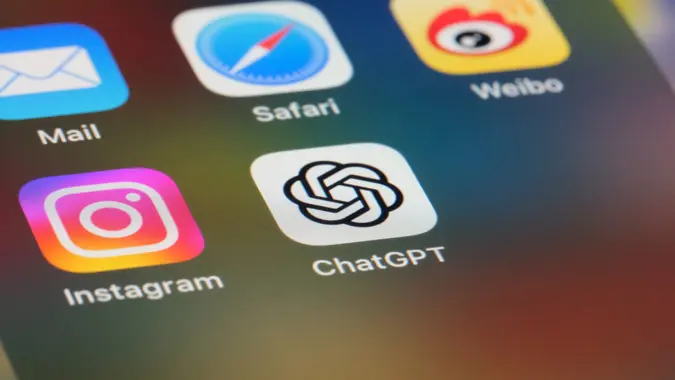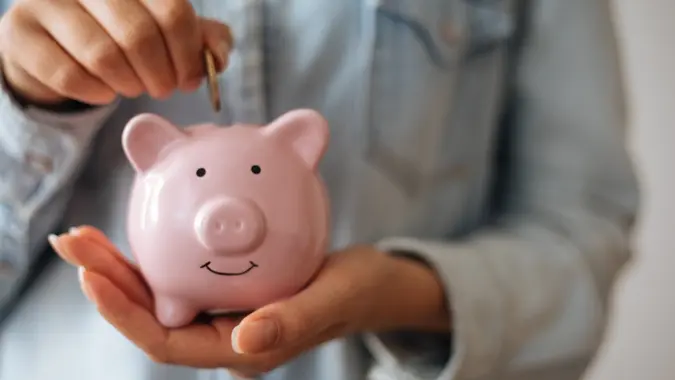I’m Living Paycheck to Paycheck — How Am I Supposed To Build an Emergency Fund?

Commitment to Our Readers
GOBankingRates' editorial team is committed to bringing you unbiased reviews and information. We use data-driven methodologies to evaluate financial products and services - our reviews and ratings are not influenced by advertisers. You can read more about our editorial guidelines and our products and services review methodology.

20 Years
Helping You Live Richer

Reviewed
by Experts

Trusted by
Millions of Readers
You’ve likely heard that an emergency fund is the cornerstone of any financial plan. Most advisors suggest socking away at least three to six months’ worth of income to build a proper savings account. But according to a 2024 CNBC survey, a sizable 65% of Americans live paycheck to paycheck, with nothing left in their accounts at the end of every month.
In that scenario, many simply give up on the idea of saving, thinking that they will never be able to save as much as they should. The reality is, nothing could be further from the truth. Many millionaires started with little to nothing and used a simple, consistent savings plan to begin amassing their fortunes. The important thing is to find a way to start.
Here are some ways that you can.
Save Before You Spend
There’s a popular adage in the investment world which says you should “pay yourself first.” While it’s becoming a bit trite since it is repeated so often, the principle behind it is absolutely fundamental if you’re struggling to save.
Whenever you get a paycheck, immediately allocate a certain percentage or amount to your savings. Then, build your day-to-day budget around what remains, instead of vice versa. While this may take some getting used to at first, once you get in the habit of doing it every month, you’ll find it becomes much easier.
Start Small
You’ve likely heard the expression that “the longest journey begins with the first step.” This is definitely true when it comes to saving as well. Rather than looking at the enormity of saving three to six months of income in your emergency fund, think small instead. For your first month, try socking away just $100. That’s $25 per week, or about $3.33 per day. It may hurt a little bit at first saving that money instead of spending it, but if you’re determined, you’re likely to find a way to absorb that cost in your monthly budget.
Once you see how your savings are building, you might get encouraged to save even more. If you save just $100 per month, you’ll end up with $1,200 in your emergency fund after the first year. While that’s not three to six months of your earnings, financial pundits like Dave Ramsey say that the first $1,000 is the most important, because it’s enough to keep you out of debt for common financial emergencies.
Be Consistent
The key to building your savings is to be consistent. If you’re trying to build even a $1,000 emergency fund, setting aside $100 in the first month and then not doing it again for another six months isn’t a good way to do it. In fact, it’s highly likely that you’ll run into some type of financial emergency before you even build your fund.
The best way to avoid this situation is to automate your contributions. That way, no matter what else happens, your money will be diverted from your paycheck to your emergency fund without you even having to do anything. This takes emotion out of the equation and also ensures that your contributions are made even if you forget.
Keep Separate Accounts
One of the keys to building an emergency fund is to make sure you only use it for actual financial emergencies. This is why it’s a good practice to keep your emergency fund separate from your daily checking account.
When your emergency fund is in a separate account, it’s more “out of sight.” This helps prevent you from thinking of it as your day-to-day money, making it less likely you’ll spend it.
Certainly, this little psychological trick doesn’t work for everyone. But having a separate account should at the very least make you think twice before you try to use it for anything other than an emergency.
Another way to put up an artificial wall between you and your emergency fund is to use a high-yield savings account at a separate bank with no ATM or debit card access. This means it will take additional steps for you to withdraw that money, making it more likely you will leave it alone.
Get Creative
If you’re really stretched to the breaking point when it comes to your monthly budget, you can still find ways to build an emergency fund. Cutting expenses or increasing your income are two things that can help.
For example, if you’re spending $100 per month on five different streaming services, find a way to cut that down to just one or two. That can save you $60 to $80 per month alone, which you can reallocate to your emergency fund. Other options include eating out less per month, shopping around to lower grocery bills or trimming internet or cell phone packages down to the basics. Anything you can do to save even $100 per month will go a long way to shoring up your savings.
On the income front, consider working extra shifts or picking up a side gig. If you get any “found money,” like tax refunds or year-end bonuses, divert some or all of that money into your emergency fund. Anytime you have money in your pocket that you aren’t expecting, tuck it away before the urge to spend it kicks in.
 Written by
Written by  Edited by
Edited by 

























